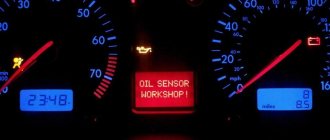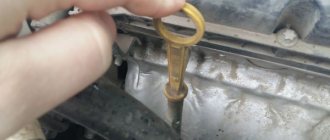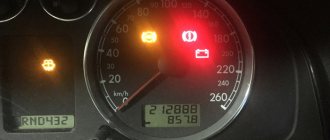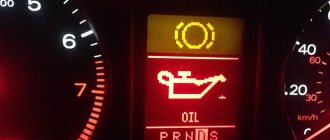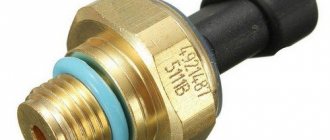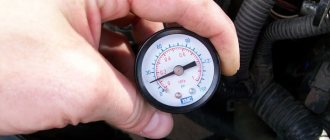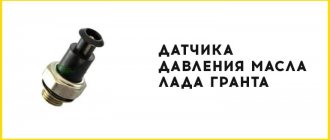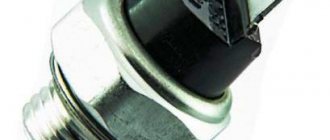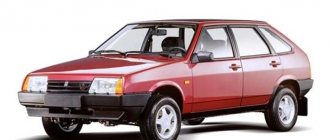A fairly common problem during the operation of an internal combustion engine is the oil pressure light on the dashboard coming on. This lamp indicates that the engine oil pressure in the engine lubrication system drops below the permissible level. Low engine oil pressure can occur for various reasons. Among the main malfunctions, experts identify:
- malfunction of the oil pressure sensor;
- low quality motor oil;
- mismatch of engine oil for a specific engine type;
- decrease in oil level as a result of a leak or increased oil consumption (waste, problems with rings or valve stem seals);
- using oil whose characteristics are not suitable for current operating conditions (viscosity index too high or low);
- oil pump malfunctions, decreased performance;
- blockage of the oil filter or oil channels of the engine lubrication system;
We also recommend reading the article about whether it is worth using additives to reduce engine oil consumption. From this article you will learn about the operating features of these compounds and the possible consequences of using additives in engine oil.
Next, we will focus on the problem when the emergency oil pressure reduction light comes on cold and/or hot. In other words, the oil pressure warning light does not go out or blinks/blinks after starting a cold engine, and the oil pressure warning light also lights up on a warm engine that is idling.
What does the lamp indicate?
The indicator light on the dashboard reacts strictly to engine oil pressure. Due to the level being reduced within reasonable limits, the signal will not appear on the panel. The exception is the loss of 2/3 of the lubricant when the oil intake of the pump begins to pick up air and crankcase gases. Then the pressure in the lubricating channels will inevitably drop, to which the sensor will react and the light will light up.
The oil receiver is specially installed at the bottom of the pan so that the system operates when there is a lack of lubrication
The circuit, signaling problems with lubrication of the power unit, consists of parts that also periodically break. So a flashing lamp does not always mean fatal engine failure. But if it lights up on your car, then you need to act like this:
- Stop moving.
- Turn off the engine.
- Check the lubricant level and, if necessary, add up to normal. The lubricant level in the car engine is checked with a special dipstick
- Topping up did not work - transport the car to the garage or to a car service using a tow truck or in tow.
- If the indicator light is intermittent (flashing), then move to the repair site under your own power at low speed. Monitor the coolant temperature gauge and pressure light: when it stops flashing and lights up, immediately turn off the engine.
In your garage, you can find the cause of the alarm if you follow the steps below.
Is it possible to drive a car?
To answer the question whether it is possible to drive with the oil can indicator on, you need to understand that modern cars are equipped with two icons. If the yellow light comes on, it indicates a decrease in the oil level, and the red light indicates a sharp drop in pressure.
Automakers do not prohibit driving with a yellow light, but you shouldn’t delay adding it. The pump, of course, will provide the required pressure, especially since the circulation of the lubricant will not stop. After a critical decline, problems will occur with the pump and then with the engine. After the yellow oil can lights up, you are allowed to drive no more than 100-200 km.
If the red light comes on, then you can no longer operate the car. The indicator indicates a strong drop in pressure, which cannot ensure the required lubricant circulation. If you continue to drive the car, the engine will overheat. It will start making noise and then instantly fail. Accordingly, the driver will have to pay for major engine repairs. This will cost him a large sum.
Oil pressure light comes on at idle, check methods
Now let's talk about the case when the low oil pressure warning light comes on while the engine is idling. Below we present available methods for identifying malfunctions, which will generally be useful in diagnosing the condition of the engine lubrication system and engine oil pressure.
- If the oil pressure light comes on, then you should check the engine oil level in the engine and its condition. If the level drops, add oil. A suspicious condition of the oil (black color, excessive thickness) will require thorough flushing of the oil system and subsequent oil change. The smell of gasoline/diesel, emulsion on the oil filler cap, or severe dilution of the engine oil will indicate problems with or cracks. On a working engine, the combustion chambers should be sealed, fuel and antifreeze should not enter the lubrication system.
- The oil pressure lamp may come on at idle immediately after changing the oil during the first start. In this case, the warning light may remain on for 10, 15 or even 20 seconds. If after the specified period of time the low oil pressure lamp does not go out, then you should check the oil filter. The product may be of poor quality, poorly screwed (oil leaks are noticeable in the area where the filter is attached) or defective.
- Check the oil pressure sensor. The oil pressure level at idle speed at around 800 - 900 rpm should not be less than 0.5 kgf/cm2. It is also worth noting that emergency oil pressure sensors on different engines may have different response ranges, which on average range from 0.4 to 0.8 kgf/cm2. This means that if there is a sensor designed to operate at 0.7 kgf/cm2, already during a pressure drop to 0.6 kgf/cm2 the sensor will turn on the emergency oil pressure lamp. This is done for conditional notification of a decrease in pressure in the line of the internal combustion engine lubrication system.
The initial check of the sensor should be done by slightly increasing the crankshaft speed (1000-1100 rpm). In other words, if the oil pressure light goes out when you press the gas, then the following options are possible:
- idle speed is too low (the light blinks at idle);
- low oil pressure in the lubrication system;
- malfunction of the oil pressure sensor;
- engine malfunction;
To accurately measure the oil pressure in the engine, you need to unscrew the sensor and install a pressure gauge in its place. Also, one should not exclude false alarms of the oil pressure sensor at idle speed, which may occur due to contamination of both the device itself and the engine oil channels. In this case, you will need to clean the sensor and clean the lubrication system channels.
As for engine breakdowns that lead to a decrease in oil pressure, indirect signs are increased consumption of fuel and engine oil, the engine emits blue or bluish smoke. In such cases, the oil pressure lamp lights up at idle, taking into account the warmed-up engine. This occurs due to the fact that the heated lubricant liquefies and flows freely through the gaps between various parts (liners, shaft journals, etc.).
Another reason could be a malfunction of the oil pump itself. During engine operation, wear of the gear pair and the internal and external surfaces of the oil pump housing may occur. Let us add that engineers set the pump’s performance to be such that it initially allows you to create pressure higher than that recommended for the motor. It turns out that the pump always pumps oil “with a reserve”. In this case, the oil pump is driven from the crankshaft, that is, the oil pressure depends on the speed (crankshaft rotation speed).
As you know, at idle the crankshaft speed is minimal. At the same time, the oil pump also develops a minimum pressure. As a result, a relatively small deviation can lead to the oil pressure lamp coming on at idle, while when the speed rises and the oil pressure in the lubrication system increases, the problem of the low oil pressure warning lamp on the dashboard coming on may not appear.
Engine oil pressure: what it depends on, how to measure it correctly. What is the oil pressure on different engines in idle mode and under load.
Why there may be low oil pressure in the engine, the oil pressure light blinks at idle or under load. Fault diagnosis and repair.
How to choose
The oil pressure sensor is selected based on the characteristics of the engine. For this reason, it will not be difficult to find the original and the closest analogues: you just need to indicate to the store manager or enter the make and model of the vehicle and the internal combustion engine data into the search engine of the electronic catalog.
Another option: look for the sensor by VIN code. This way, the likelihood of making a mistake with your choice is reduced to zero. You will find exactly what you can install on your car.
Choosing a cheap non-original is not advisable. The fact is that the device may fail earlier than expected, and in principle it does not last as long as the original. As a result, the car owner will save once, but then overpay
. When choosing any sensor, study the packaging, device and price. Here's what to consider:
- Quality of packaging materials, printing. Both should be at the same level. Fonts that are too small, worn out letters and numbers indicate a fake;
- Complete set. The kit includes the sensor itself and an O-ring;
- Price. A product that is too cheap is highly likely to be a fake. Study the prices on the auto parts market and remember that strong discrepancies with prices on the branded parts market indicate that you have a fake sensor;
- No mechanical damage. There should be no chips or cracks on the body.
Source
Main reasons
- Minimum oil level. Today this reason is considered one of the most common. When using the vehicle regularly, it is recommended to carefully monitor the oil level and try to notice various drips on the engine body. Any, even the smallest oil stains under the car are sufficient reason to check the oil system.
- Using bad filters. A certain amount of oil should always remain in the filter, regardless of the stop of the power unit. This is required so that the effect of “engine oil starvation” does not form. As practice shows, many low-quality filters do not retain oil, so it flows into the crankcase without any problems. The only way to cope with this situation is to replace the filter with a better one.
- Wiring fault. Very often the oil pressure light stays on for a long time due to wiring problems. It is located on the panel and connected to the sensor via a wire. If the oil pressure drops below a certain level, the sensor closes the light to ground. When the pressure becomes normal, the contacts open and the light goes out. However, if the sensor itself is broken, the light will not turn off. In this situation, it is necessary to conduct a thorough diagnosis, replace the wiring, as well as parts that have failed.
- Reducing valve failure. If the pressure level is minimal, then the working pressure relief valve will be located in the closed position. If it freezes or gets stuck in the open position, the required pressure will not be generated in the system, and accordingly, the light will be constantly on.
- The pump screen is clogged. It is this part that is responsible for effectively protecting the pump, as well as the power unit, from the penetration of all kinds of debris onto various surfaces. Hard chips, dirt, dust and other objects - all this has a negative impact on the surface of numerous parts. If the oil is clean, free of all kinds of contaminants, then it easily passes through the mesh. At this moment, the sensor is set to a “quiet state,” which confirms the normal functioning of the motor. However, when the oil becomes dirty and moves poorly through the filter, it is not possible to provide the required pressure. To solve this problem, it is necessary to replace the oil pan.
- Oil pump failure. If this device cannot guarantee the pressure necessary for high-quality lubrication, then the contacts are closed, accordingly, the light will constantly signal to the driver that there is a fairly serious malfunction in his vehicle.
If the pressure light is dim, you should check the wiring or replace the light bulb itself.
You can learn about the oil pressure in your car from the article What is the oil pressure.
Reasons why the pressure sensor is on
When everything is clear with the sensor and it is working properly, another question arises. Why does the pressure indicator light up? There are many reasons.
Incorrectly selected oil viscosity, which is especially important at low temperatures, when high oil viscosity loads the oil pump and prevents it from working correctly.
The viscosity of the engine oil may change due to contamination, which will also cause the indicator to light up or flash
The oil pump pressure reducing valve is faulty:
– the valve spring is broken or stretched due to wear;
– the valve clearance is clogged due to dirty engine oil or a worn oil filter
Remove the oil pump.
Take corrective action or replace
Oil leak due to:
– worn out old gaskets and sealing rings;
How does the oil pressure indicator work?
Controlling the pressure in the lubrication system is simple. A sensor is installed in one of the channels of the lubrication system that responds to changes in pressure. This sensor is connected by an electrical circuit to the warning light on the dashboard.
The operating principle of this scheme is also simple. If there is no pressure, the sensor closes the circuit, so when the ignition is turned on, the light comes on, indicating that the electrical circuit is working. After starting the engine, the oil pump pumps oil, so the pressure in the channels increases. When a certain value is reached, the sensor opens the circuit and the light goes out.
The sensor itself is set to the minimum pressure required for normal engine operation. This indicator differs on different models; on some engines the working indicator is 0.3 - 0.4 kgf/cm2 at idle, at speeds of 2000-3000 and more than 0.5-0.7 kgf/cm2.
When operating the machine, a problem arises when the pressure indicator lamp lights up while the engine is running, and its light may vary. For some, the control lights up at idle and the glow is dim, while for others the signal is bright and appears at medium and high speeds. If the lamp lights up at idle and goes out when driving, then you need to look for the cause.
And under whatever conditions the warning system is triggered, measures must be taken immediately. The lubrication system directly affects the performance of the engine and its malfunction will result in serious damage.
The first thing the driver should do when the lubrication pressure light comes on is to stop driving and turn off the engine. The next step is to identify the reason for the alert.
Why does the oil pressure light come on in VAZ 21142115
There are several likely reasons why this car light suddenly comes on. And only based on an accurate determination of the cause can the necessary actions be taken to eliminate the malfunction.
The indicator may light up in two cases:
at engine idle speed;
when the car is moving.
Each of these cases has its own causes of malfunctions.
The light came on at idle
The oil pressure light may come on (or blink) at idle, and if you press the gas pedal, the icon will immediately go out. In this case, the most likely causes of malfunctions are the following:
the crankshaft liners are worn out: the oil pressure will drop due to the fact that the gap between the thinned liner and the car’s connecting rod has increased;
the oil receiver mesh is severely clogged: one of the most common reasons why a light bulb suddenly lights up. Various types of sediment are gradually deposited on the surface of the engine sump. At the moment when there are too many deposits, the pump can no longer supply enough oil to operate the engine;
wear or any problems in the oil pump: another probable reason why the indicator may light up on a VAZ 2114/2115. Due to a breakdown of the pump itself or any part of it, oil does not enter the engine in the required quantity;
the sensor is faulty: it is quite possible that the oil level and the engine itself fully meet their basic characteristics, and the problem lies in the sensor;
the wiring is shorted: problems in the car’s electronic system can also cause the engine oil supply system to not operate correctly.
The oil can indicator light came on while driving.
In cases where the oil pressure light suddenly comes on while the car is moving, it is advisable to stop immediately. Probably the following failure or breakdown occurred:
the oil level in the engine unit is below the Min mark;
the oil filter could be clogged - this leads to the fact that the pressure invariably decreases;
it's time to change the oil - in cases where the car owner does not replace the substance in the engine for a long time, it loses its working properties.
Problems after oil change
After changing the oil, the light may come on in the following cases:
- low-quality oil was poured;
- a low-quality oil filter is installed;
- pressure relief valve jammed;
- after installing the engine sump (if it was removed), the oil receiver could be close to the bottom of the sump and at high speeds the pump does not have time to pump oil, the light will indicate a lack of pressure;
- the pump has reached the end of its service life and requires repair or replacement.
Video of oil pressure light blinking
I myself am an experienced motorist and I know when the oil pressure light starts blinking, it’s always not good. I'll list them point by point.
1) Excessive engine wear. This means that the engine has high output and the oil pressure is below normal levels. Usually happens after a long mileage of the engine. BUT I don’t have that much mileage, the car is only in its second year.
2) The oil is not suitable for the engine. It happens that the oil is not suitable for the engine. This happened on our “classic” VAZs when they filled in oil that was too “thin” for them. At idle speed when the engine warmed up, the lamp began to blink indicating that the pressure in the engine was not enough. You just need to change the oil. But I have the oil that the manufacturer himself recommends, and made under his supervision (GM oil).
GM oil
3) Insufficient oil level. Just pull out the oil dipstick and check the level. It should be at average and not higher than “maximum”. If the oil is above the maximum mark, then it needs to be removed; more details in the article - excess oil in the engine. If the oil level is below the level, simply add it up to the norm to avoid oil starvation of the engine.
normal level
BUT my oil is always fine, I check it every day.
4) The oil pressure sensor is faulty. The oil pressure sensor is malfunctioning and, even though the oil level and pressure are normal, it provides incorrect information to the vehicle’s instruments.
In general, after I arrived at the official station and showed the fault, I was advised to add some oil to the engine. I bought exactly the same oil as mine, but the situation did not improve, the lamp still blinked.
add oil
into the engine neck
Then they took my car to the station for detailed diagnostics.
An hour later (+ free car wash) it turned out that the oil pressure sensor had failed. I just felt better, because engine repair is very serious, and an oil sensor costs pennies. At VAZ, I changed it in half an hour. But then it turned out that the Chevrolet Aveo oil pressure sensor is located at the bottom and changing it is not so easy. Therefore, my car was left for four hours, I agreed to pick it up in the morning.
Where is the sensor located?
Good to know
On most vehicles, the meter is installed in close proximity to the cylinder head and oil filter.
In order to gain access to the device, you may need to remove the wheel or crawl under the bottom of the car.
Location of the oil pressure sensor
Table: location of DDM on popular car models
| The model of car | Place where the measuring element is located | How to access the controller |
| Lada Kalina (Lada Kalina) | The oil pressure gauge is located on the right rear part of the power unit - in a separate socket of the main cylinder block next to the belt guard. One cable must be connected to the controller. | At the top of the motor. To gain access, the user must remove the plastic cylinder block cover. |
| VAZ 2108/2109/21099 VAZ 2110/2111 (8 valve engine) | The device is located on the right side of the power unit, in a special socket in the cylinder head, next to the belt protective shield. One cable must be connected to it. | Above |
| VAZ 2110/2111 with 16 valve engine | The controller is located at the rear of the power unit on the camshaft block. One cable is connected to the measuring element, next to it there are two bundles of wires enclosed in black insulation. | Above |
| Audi (Audi) - most of the modern models | Near the oil filter device. Depending on the model, there may be an additional meter located on the main cylinder block. One cable is connected to the pressure sensor. | At the top of the engine |
| Chevrolet Lanos (Chevrolet Lanos) | On the oil pump device from the bottom of the power unit. A bundle with cables in a separate insulator must be connected to the sensor. | At the bottom of the engine. The device can only be accessed from under the bottom if the machine is located on a pit or overpass. |
| Ford Transit | In the middle under the front bumper of the car, next to the oil cooler. | |
| Renault Trafic (Renault Traffic) | The engine contains a special device with an oil filter and a heat exchanger. The sensor itself is screwed into the thread on the channel after the oil filter. | Above |
| Mercedes-Benz (Mercedes Benz) - most of the modern models | On these car models, the oil pressure sensor is located on the crankcase on the right side of the central part of the car | At the bottom of the engine. The device can only be accessed from under the bottom if the machine is located on a pit or overpass. |
| Mitsubishi Lancer (Mitsubishi Lancer) | The sensor is located on the rear side, slightly to the right of the motor. The meter is screwed into the power unit next to the lubricant filter. One cable is connected to the sensor. | |
| Nissan X-Trail (Nissan X-Trail) | The device is located in the lower part of the cylinder block, next to the pumping device of the power steering system. | To gain access, the user must remove the right wheel and remove the plastic belt cover. |
| Opel Astra (Opel Astra) | The sensor is located at crankcase level on the right side of the generator set. One cable is connected to the controller. | To change and install a new controller, you need to remove the right front wheel |
| Volkswagen Golf, Jetta (Volkswagen Golf and Jetta) | The measuring device is located at the end of the cylinder head. These cars are equipped with two controllers, the second is designed to record insufficient pressure and is located on the oil filter to the right of the car. | The sensors are located at the top and bottom of the motor, respectively. |
| Volkswagen Passat | The car is equipped with two measuring elements. The first is located on a special bracket upstream of the lubricant filter, the second is located at the outlet of the filter. | Above |
| BMW E39 | The sensor is located on the oil filter cup and is parallel to the power unit. There are two controllers here, one records the temperature, the other records the pressure. | Above |
| Gazelle with power unit ZMZ-405 | The sensor is located on the right side of the main cylinder block, in its upper part. One cable is connected to the meter. | Above |
The role of the oil pressure indicator
The red light, marked on many cars with the image of an oil can, was added to the dashboard for a reason. It is connected to a common electrical circuit with a sensor mounted in one of the channels of the engine lubrication system. When the element detects a pressure drop below a critical level, the circuit closes and the lamp flashes red, informing the driver of an emergency malfunction.
The signal from the red lamp with the image of an oil can indicates a malfunction of the engine lubrication system
The purpose of the emergency lamp is to warn the car owner in time about the engine's oil starvation. If for various reasons it does not light up or the driver ignores the red “oil can” signal on the instrument panel, then the following consequences may occur:
- due to lack of lubrication, the crankshaft journals wear out, the sliding bearings (liners) may rotate and finally jam; As a result of oil starvation, wear appears on the crankshaft journals
- In the absence of oil, the piston skirts will overheat and expand in volume, leaving scratches and scuffs on the cylinder walls; A poorly lubricated piston heats up and leaves scuff marks on the cylinder wall
- the camshaft bearings located at the highest point of the engine will fail; Without lubrication, the camshaft bearings quickly fail
- the service life of the remaining rubbing parts will be sharply reduced.
Insufficient amount of lubricant or its absence in any case leads to breakdown and costly repair of the power unit. A timely signal on the dashboard will help avoid this.
Mechanical sensor check
To check the mechanical oil pressure sensor, it must also be removed from its seat and covered with a rag. The method for checking them is a little more complicated than electronic ones. And it is carried out according to the following algorithm of actions:
- First, you need to determine which of the contacts outputs a signal to the dashboard hazard indicator lamp. And the second contact of the oil pressure signal. The oil pressure sensor housing is used as a “ground” when assembling the chain.
- Then, on the electronic pressure gauge of the compressor, you need to find where to connect the “plus” and “minus” power and signal contacts from the sensor.
- Having decided on the contacts, an electrical circuit is assembled. The compressor hose is connected and securely sealed to the sensor sensing element.
- A pressure of about 1 – 2 atmospheres is created.
If the sensor is working properly, the pressure gauge will show the corresponding value. Otherwise, the sensor has failed. DDMs, as a rule, cannot be repaired, so when faults are identified, they are simply replaced with new ones. Moreover, they are inexpensive and can be found in any auto store.
The system failure indicator is on
Almost every car owner has encountered a situation where the red lubricant pressure lamp on the instrument panel lights up. But not all drivers know what to do in such a case.
After all, the situation can occur at any moment - both while the vehicle is moving and at idle speed. Definitely, if this problem occurs, the car requires repair work.
There are many reasons for the occurrence of an indicator signal. The driver is recommended to adhere to a certain rule: you cannot continue driving if the indicator lights up.
Neglecting the recommendation can lead to irreversible consequences, namely major damage to the car. The optimal solution in this situation is to call a tow truck and go to a car service center to diagnose the control system.
Motor oil, in addition to its main function of lubrication, acts as a cooling agent. If the pressure in the power unit decreases, then, consequently, the temperature of the mating elements increases.
The motor begins to wear out, that is, under extreme operating conditions. It is worth noting that hot oil loses its positive properties and loses its function of creating a special film on engine parts and mechanisms.
